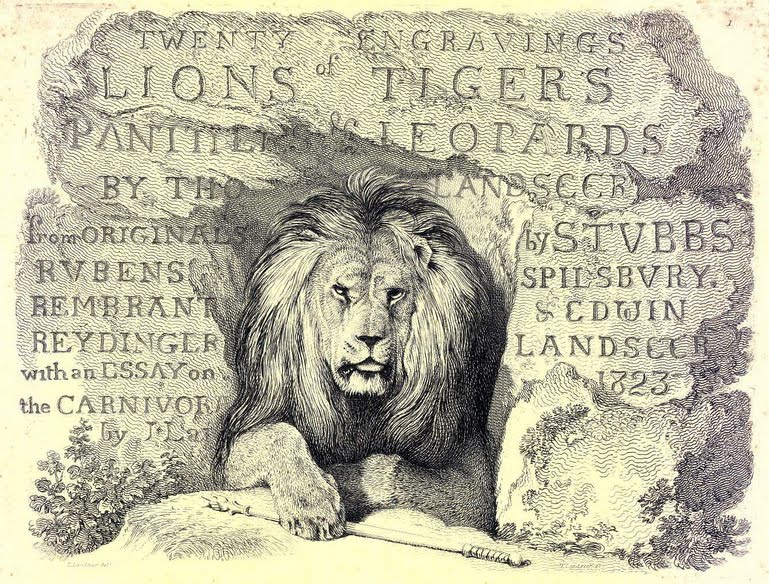Book of the Week: Big Cats Week!
 This week is Big Cats Week, and to celebrate we’re featuring a book in our collection that has some of the loveliest engravings of these majestic felines that we’ve ever seen. The book, Engravings of Lions, Tigers, Panthers, Leopards, Dogs, etc. (1853), by Thomas Landseer, contains 39 plates. The first twenty – of lions, tigers, panthers, and leopards – are engravings by Thomas Landseer after original works by Stubbs, Rubens, Spilsbury, Rembrant, Reydinger, and Edwin Landseer.
This week is Big Cats Week, and to celebrate we’re featuring a book in our collection that has some of the loveliest engravings of these majestic felines that we’ve ever seen. The book, Engravings of Lions, Tigers, Panthers, Leopards, Dogs, etc. (1853), by Thomas Landseer, contains 39 plates. The first twenty – of lions, tigers, panthers, and leopards – are engravings by Thomas Landseer after original works by Stubbs, Rubens, Spilsbury, Rembrant, Reydinger, and Edwin Landseer.
We hope you enjoy these marvelous works, and for each of the species depicted, we’ve included some interesting facts and links to the animals in EOL, where you can learn even more about them. Be sure to check out Big Cats Week on the National Geographic website, and you can follow the discussion on twitter (BHL account – @BioDivLibrary) with the hashtag #bigcatsweek. And remember, you can see all of the illustrations from this work on our Flickr account.
- Second largest living cat
- The tallest of all living cats
- Until about 10,000 years ago, the lion was the most widespread mammal after humans, with ranges including Africa, Europe, Asia and even the Americas
- Usually, eight subspecies of lions are recognized
- Lions can be bred with tigers, leopards, and panthers, producing, respectively, ligers, leopons, and jaglions
- The only member of the cat family to display obvious sexual dimorphism (with the manes on males)
- The largest of all cat species
- The longest canine teeth among living felids
- Six living recognized subspecies
- The subspecies of tigers are the most varied in size of any cat species. The Siberian, Bengal and Caspian are the largest living felids and some of the largest to ever live. While males of these varieties can weigh between 600-670 pounds, the smallest tiger subspecies, the Sumatran, weighs only 170-310 pounds.
- The South China Tiger subspecies is listed as one of the 10 most critically endangered animals in the world, and indeed may already be extinct in the wild.
- The panther may refer to the leopard in Africa and Asia, the cougar in North America, or the jaguar in Central and South America.
- The jaguar resembles the leopard physically but is larger
- The jaguar has an exceptionally powerful bite, crushing the skulls of prey to deliver a “death-bite” to the brain
- The mountain lion, cougar, or puma, native to the Americas, has the largest range of any large wild terrestrial mammal in the Western Hemisphere
- The cougar is closer genetically to the domestic cat than true lions
- The smallest of the four big cats (lion, tiger, jaguar and leopard)
- It is chiefly found in sub-Saharan Africa, though small populations can be found in Asia
- Both leopards and jaguars that are completely black are known as black panthers
- There are nine recognized subspecies of leopards
- The Amur Leopard, one of the nine subspecies, is considered one of the rarest felids in the world, with only approximately 30-35 individuals in the wild
- The Arabian Leopard is the smallest leopard subspecies
- The Persian Leopard is the largest leopard subspecies









If you would like to find a copy of this book, there are several book seller sites that you could explore. This will also give you an idea of the cost of procuring the book. We recommend:
http://www.abebooks.com – Searches the listings of booksellers in the US, Europe, and around the world
ViaLibri – an online searchable database of the inventories of thousands book dealers in the US and Europe. There, one can search to see if there are any copies currently in the market.
Antiquarian Booksellers Association of America (ABAA) – A more exclusive gathering of reputable book dealers. Member booksellers can be searched by subject matter (as well as name and geographic location) including map sellers and those that offer appraisals.
And remember, you can get a digital copy of the entire book on BHL: http://biodiversitylibrary.org/bibliography/29771
I wanted to have a copy of that book, does anyone know how much is the price or where should I buy that book?